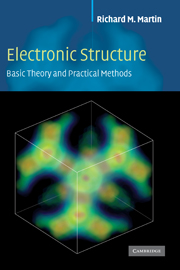Book contents
- Frontmatter
- Contents
- Preface
- Acknowledgments
- Notation
- Part I Overview and background topics
- Part II Density functional theory
- Part III Important preliminaries on atoms
- Part IV Determination of electronic structure: the three basic methods
- 12 Plane waves and grids: basics
- 13 Plane waves and grids: full calculations
- 14 Localized orbitals: tight-binding
- 15 Localized orbitals: full calculations
- 16 Augmented functions: APW, KKR, MTO
- 17 Augmented functions: linear methods
- Part V Predicting properties of matter from electronic structure – recent developments
- Appendix A Functional equations
- Appendix B LSDA and GGA functionals
- Appendix C Adiabatic approximation
- Appendix D Response functions and Green's functions
- Appendix E Dielectric functions and optical properties
- Appendix F Coulomb interactions in extended systems
- Appendix G Stress from electronic structure
- Appendix H Energy and stress densities
- Appendix I Alternative force expressions
- Appendix J Scattering and phase shifts
- Appendix K Useful relations and formulas
- Appendix L Numerical methods
- Appendix M Iterative methods in electronic structure
- Appendix N Code for empirical pseudopotential and tight-binding
- Appendix O Units and conversion factors
- References
- Index
16 - Augmented functions: APW, KKR, MTO
from Part IV - Determination of electronic structure: the three basic methods
Published online by Cambridge University Press: 05 June 2012
- Frontmatter
- Contents
- Preface
- Acknowledgments
- Notation
- Part I Overview and background topics
- Part II Density functional theory
- Part III Important preliminaries on atoms
- Part IV Determination of electronic structure: the three basic methods
- 12 Plane waves and grids: basics
- 13 Plane waves and grids: full calculations
- 14 Localized orbitals: tight-binding
- 15 Localized orbitals: full calculations
- 16 Augmented functions: APW, KKR, MTO
- 17 Augmented functions: linear methods
- Part V Predicting properties of matter from electronic structure – recent developments
- Appendix A Functional equations
- Appendix B LSDA and GGA functionals
- Appendix C Adiabatic approximation
- Appendix D Response functions and Green's functions
- Appendix E Dielectric functions and optical properties
- Appendix F Coulomb interactions in extended systems
- Appendix G Stress from electronic structure
- Appendix H Energy and stress densities
- Appendix I Alternative force expressions
- Appendix J Scattering and phase shifts
- Appendix K Useful relations and formulas
- Appendix L Numerical methods
- Appendix M Iterative methods in electronic structure
- Appendix N Code for empirical pseudopotential and tight-binding
- Appendix O Units and conversion factors
- References
- Index
Summary
Summary
Augmentation provides a method of constructing a basis that is in some ways the “best of both worlds:” the smoothly varying parts of the wavefunctions between the atoms represented by plane waves or other smoothly varying functions, and the rapidly varying parts near the nuclei represented as radial functions times spherical harmonics inside a sphere around each nucleus. The solution of the equations becomes a problem of matching the functions at the sphere boundary. The original approach is the augmented plane wave (APW) method of Slater, which leads to equations similar to the pseudopotential and OPW equations, but with matrix elements of a more complicated, energy-dependent potential operator. The disadvantage of augmentation is that the matching conditions lead to non-linear equations, which has led to the now widely used linearized methods described in Ch. 17. The KKR method is a multiple-scattering Green's function approach that yields directly local quantities. The muffin-tin orbital (MTO) approach reformulates the KKR method, leading to physically meaningful descriptions of the electronic bands in terms of a small basis of localized, augmented functions.
Augmented plane waves (APWs) and “muffin tins”
The augmented plane wave (APW) method, introduced by Slater [54] in 1937, expands the eigenstates of an independent-particle Schrödinger equation in terms of basis functions, each of which is represented differently in the two characteristic regions illustrated in Fig. 16.1. In the region around each atom the potential is similar to the potential of the atom and the solution for the wavefunction is represented in a form appropriate to the central region of an atom.
Information
- Type
- Chapter
- Information
- Electronic StructureBasic Theory and Practical Methods, pp. 313 - 344Publisher: Cambridge University PressPrint publication year: 2004
